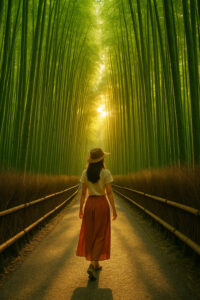The moment I arrived in Kyoto, I felt like I had stepped into a painting — one where time moved slower and every sound carried meaning. The air was cool and fragrant with incense, temple bells echoed in the distance, and everywhere I looked, history whispered through wooden gates and moss-covered stone paths. As a Filipina traveler visiting for the first time, I found myself both awed and comforted by Kyoto’s balance — a city where sacred rituals meet the quiet hum of modern life. If you’re planning your first visit, here are twelve unforgettable things to do in Kyoto that will leave you enchanted long after you’ve left.
Cultural Kyoto: The Soul of Japan
My first morning began at Fushimi Inari Taisha, one of Kyoto’s most iconic sites. The famous vermillion torii gates rose like waves of color up the mountain trail, each one inscribed with the name of a donor. I started my walk early, when the sun was soft and the crowds still light. The rhythmic sound of my footsteps against the gravel and the rustle of leaves above created a sense of calm I hadn’t felt in years. Midway up, I paused at a small tea stall run by an elderly couple. They served me green tea in clay cups, smiling as I thanked them in broken Japanese. It was a moment of pure connection — no words, just warmth.
Next, I made my way to Kiyomizu-dera Temple, perched on a hillside overlooking the city. Its wooden stage juts out dramatically over a sea of maple trees, and in spring, it feels like floating above a pink and white cloud of blossoms. The temple’s name means “pure water,” and visitors line up to drink from its sacred streams for luck in love, longevity, or wisdom. I took a sip, unsure which blessing I needed most, but grateful nonetheless.
In the nearby streets of Higashiyama, I wandered through narrow lanes lined with old machiya houses and traditional tea shops. One tiny teahouse called Kasagi-an invited me in for a matcha ceremony. Watching the host whisk the green tea into a fine froth, I realized that the beauty of Kyoto lies not just in its monuments, but in its rituals — simple acts performed with intention and grace.
Nature & Peace: Kyoto’s Gardens and Bamboo Forests
Among all the things to do in Kyoto, walking through Arashiyama Bamboo Grov e is an experience unlike any other. I arrived at sunrise, when the path was quiet and the bamboo glowed pale green in the early light. The air felt different here — cool, filtered, and alive. Each gust of wind made the bamboo sway and whisper like an orchestra of nature. I stood still for several minutes, just listening. It’s the kind of silence that makes you aware of your own heartbeat.
e is an experience unlike any other. I arrived at sunrise, when the path was quiet and the bamboo glowed pale green in the early light. The air felt different here — cool, filtered, and alive. Each gust of wind made the bamboo sway and whisper like an orchestra of nature. I stood still for several minutes, just listening. It’s the kind of silence that makes you aware of your own heartbeat.
After leaving the grove, I crossed the Togetsukyo Bridge, a wooden span over the Katsura River framed by mountains. Locals were feeding koi in the shallows, and a group of students in uniform walked by, laughing softly. I stopped at a riverside café for a bowl of soba noodles and a cup of hot matcha. Watching boats drift downstream, I felt time stretch and settle — Kyoto’s quiet gift to every traveler.
Later that afternoon, I visited Ryoan-ji Temple, home to Japan’s most famous Zen rock garden. Fifteen stones arranged on raked white gravel — simplicity perfected. I sat on the wooden veranda, letting my mind drift. It wasn’t about understanding the garden; it was about feeling it. And for a while, I did — a stillness that spoke louder than words.
Hidden Gems and Everyday Kyoto
Kyoto reveals itself slowly, especially if you step away from the main paths. One of my favorite discoveries was Nishiki Market, a lively food street where locals shop for produce, seafood, and snacks. I tried grilled mochi, sesame ice cream, and a delicate tamagoyaki (rolled omelet) cooked fresh before my eyes. The market buzzed with color and aroma — pickled vegetables in glass jars, seaweed sheets stacked like books, and the scent of soy and smoke from every corner.
By evening, I wandered into Pontocho Alley, a narrow riverside lane lined with wooden façades and glowing paper lanterns. Behind sliding doors, I glimpsed small izakayas filled with laughter and clinking glasses. I found a seat at a tiny restaurant that served yakitori skewers and local sake. As I ate, I noticed a geisha gliding past the doorway — poised, silent, and elegant. Kyoto has a way of making you feel like you’re moving through a dream.
Nearby, the Nishijin District offers another side of the city — traditional textile workshops where artisans still weave intricate kimono fabrics by hand. Watching them work was mesmerizing; each motion deliberate, each pattern a story. It reminded me of how culture lives not just in temples, but in everyday craftsmanship.
Modern Kyoto: Where Tradition Meets Innovation
Kyoto may be ancient, but it’s far from frozen in time. In Kawaramachi and Shijo-dori, I discovered the city’s modern pulse — chic boutiques, bookstores, and minimalist cafés hidden in renovated townhouses. One afternoon, I visited a café called Weekenders Coffee, tucked behind a quiet alley. The aroma of espresso mingled with the faint scent of tatami mats, and soft jazz played in the background. I sat by the window with a matcha latte and thought how effortlessly Kyoto marries the old and new.
For art lovers, the Kyoto International Manga Museum and the Kyocera Museum of Art showcase the city’s creative evolution. Meanwhile, boutique ryokans like The General Kyoto and Ryokan Genhouin offer the best of both worlds — traditional architecture with contemporary design and hospitality that feels deeply personal.
In the evening, I explored the Kyoto Station complex, its futuristic steel and glass architecture glowing against the night sky. From the rooftop garden, I looked down at the city lights stretching toward the mountains. Kyoto felt alive, timeless, and utterly present all at once.
Spiritual Moments: Zen, Blossoms, and Reflection
Of all the things to do in Kyoto, the moments of stillness stayed with me most. Early one morning, I joined a Zen meditation session at Shunkoin Temple. The monk spoke gently about mindfulness — not as an escape, but as a way of noticing. Sitting cross-legged on the tatami, I listened to the sound of birds and the faint ringing of a bell. In that silence, I felt profoundly grounded, as though I had finally caught up with myself.
Later that day, I walked the Philosopher’s Path, a canal-side trail lined with cherry trees. Though it wasn’t sakura season, the trees still formed a delicate canopy above the water. I passed quiet shrines, cats napping on stone walls, and cafés offering handmade sweets. The path’s name felt fitting — every step invited contemplation. I stopped by a small teahouse near Ginkaku-ji Temple and shared a matcha dessert with a local woman who told me about her childhood in Kyoto. We laughed at our language gaps and exchanged smiles that said everything words couldn’t.
As dusk approached, I found myself back in Gion. Lanterns glowed along the streets, their reflections shimmering in the canal. The sound of wooden geta sandals echoed softly on the pavement, and the air was fragrant with incense and rain. Kyoto, I realized, isn’t just beautiful — it’s deeply alive, in quiet ways that reveal themselves when you slow down enough to listen.
Why Kyoto Leaves Its Mark
 My days in Kyoto felt like poetry — soft, deliberate, and full of grace. Every shrine bell, every bowl of tea, every passing smile added up to something profound: a reminder that beauty often lives in the smallest details. Among the many things to do in Kyoto, what truly matters is what you take with you — the stillness, the patience, the appreciation for things as they are.
My days in Kyoto felt like poetry — soft, deliberate, and full of grace. Every shrine bell, every bowl of tea, every passing smile added up to something profound: a reminder that beauty often lives in the smallest details. Among the many things to do in Kyoto, what truly matters is what you take with you — the stillness, the patience, the appreciation for things as they are.
Kyoto taught me to slow down. To savor each step on a temple path, each sip of matcha, each conversation — fleeting but meaningful. And as I boarded my train home, watching the city fade into the distance, I knew I’d return not just to see Kyoto again, but to feel it.
For more culture-rich journeys, explore A Food Lover’s Day in Binondo: The Heart of Manila’s Chinatown, or plan your own Japanese adventure through Japan National Tourism Organization (JNTO) for itineraries, tours, and travel tips.
Kyoto may be centuries old, but its wisdom feels timeless — an open invitation to find peace, one quiet moment at a time.
If you would like to find more things to do in Kyoto as a tourist, have a look at this list:

